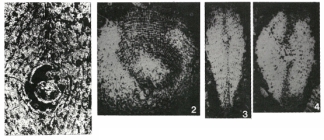Foraminifera taxon details
Rhabdorbitoides Brönnimann, 1955 †
722372 (urn:lsid:marinespecies.org:taxname:722372)
accepted
Genus
Rhabdorbitoides hedbergi Brönnimann, 1955 † (type by original designation)
marine, brackish, fresh, terrestrial
fossil only
masculine
Brönnimann, P. (1955). Upper Cretaceous orbitoidal Foraminifera from Cuba. Part IV. Rhabdorbitoides, n. gen. <em>Contributions from the Cushman Foundation for Foraminiferal Research.</em> 6(3): 97-104., available online at https://cushmanfoundation.allenpress.com/portals/_default/files/pubarchive/CCFFR/06ccffr3.pdf
page(s): p. 97 [details] Available for editors [request]
[request]
page(s): p. 97 [details] Available for editors
Hayward, B.W.; Le Coze, F.; Vachard, D.; Gross, O. (2024). World Foraminifera Database. Rhabdorbitoides Brönnimann, 1955 †. Accessed at: https://www.marinespecies.org/foraminifera/aphia.php?p=taxdetails&id=722372 on 2024-04-24
Date
action
by
original description
Brönnimann, P. (1955). Upper Cretaceous orbitoidal Foraminifera from Cuba. Part IV. Rhabdorbitoides, n. gen. <em>Contributions from the Cushman Foundation for Foraminiferal Research.</em> 6(3): 97-104., available online at https://cushmanfoundation.allenpress.com/portals/_default/files/pubarchive/CCFFR/06ccffr3.pdf
page(s): p. 97 [details] Available for editors [request]
[request]
basis of record Loeblich, A. R.; Tappan, H. (1987). Foraminiferal Genera and their Classification. Van Nostrand Reinhold Company, New York. 970pp., available online at https://books.google.pt/books?id=n_BqCQAAQBAJ [details] Available for editors [request]
[request]
page(s): p. 97 [details] Available for editors
basis of record Loeblich, A. R.; Tappan, H. (1987). Foraminiferal Genera and their Classification. Van Nostrand Reinhold Company, New York. 970pp., available online at https://books.google.pt/books?id=n_BqCQAAQBAJ [details] Available for editors
From editor or global species database
Diagnosis Test lenticular, single equatorial layer of chambers covered by lateral layers on both sides, juvenarium uniserial but not rotaloid, neanic stage with irregular rows and layers of radial rods and primary lateral chambers, two layers of radial rods near the center increase by intercalation of new rods, up to ten layers toward the margin where regular annular and irregular vertical and diagonal connections produce a lattice, primary lateral chambers rest directly on the rods and are overlain by regular tiers of secondary lateral chambers that result in the lenticular thickening, lateral chambers interconnect through basal stolons and fine pores, pillars present. U. Cretaceous (Campanian); Cuba. (Loeblich & Tappan, 1987, Foraminiferal Genera and Their Classification) [details]
